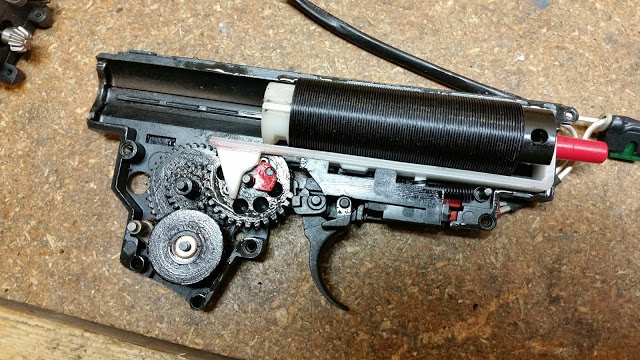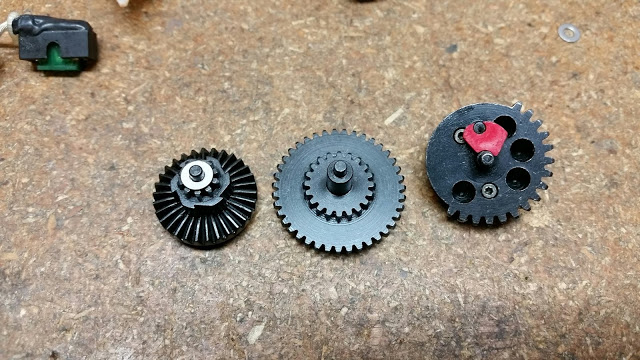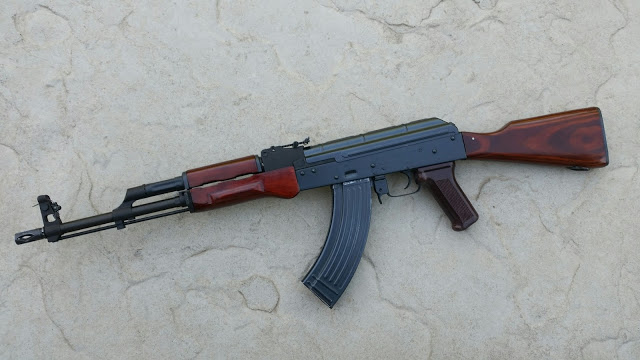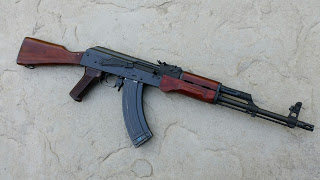 Is the E&L Gen. 2 the ‘LCT / Real Sword Killer’ of internet lore, or all hype?
Is the E&L Gen. 2 the ‘LCT / Real Sword Killer’ of internet lore, or all hype?
I’ve personally worked on a fair number of E&L’s now, mostly of the generation 1 variety. The newer, improved generation 2 models haven’t really flooded the market just yet, so this in turn means that I haven’t seen too many cross my bench yet. But even before the release of the Gen 2 models, the hype train was already in full gear and many were saying these were the rifles that would finally put LCT and Real Sword into their graves.
Recently I wound up purchasing a brand new E&L Gen 2 AKM A101. I had accrued a decent chunk of store credits from my supplier, enough that purchasing one of these at wholesale cost plus a few bucks for the difference wasn’t a big hit on the wallet. Retail pricing on the E&L Gen. 2 AKM is usually MAP enforced at $399 from most stores, which puts it among the more expensive Airsoft AK platforms you can buy these days.
Initial Impressions
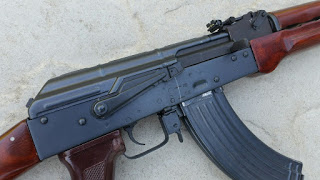 I won’t really cover the box, because who really cares about the box? For those who do care, it’s identical to the ones you receive with the Gen 1 rifles. Inside the box, you will find the rifle, manual, and a couple of “Passed Inspection” sheets from E&L and JAG Precision. The is also a real steel cleaning kit and cheapo plastic oil bottle (that does not contain oil), which are of rather dubious value to the average AEG end user. 1 120 round mid-cap magazine is included with the rifle. Unfortunately, there is no replacement metal slant brake for the plastic orange tip that comes outfitted on this rifle. And unlike Real Sword, which provides you with a couple of handy tools (such as the enormously helpful rear sight removal tool), this package does not ship with any tools whatsoever. Considering the price of these, that seems like a bit of the shaft.
I won’t really cover the box, because who really cares about the box? For those who do care, it’s identical to the ones you receive with the Gen 1 rifles. Inside the box, you will find the rifle, manual, and a couple of “Passed Inspection” sheets from E&L and JAG Precision. The is also a real steel cleaning kit and cheapo plastic oil bottle (that does not contain oil), which are of rather dubious value to the average AEG end user. 1 120 round mid-cap magazine is included with the rifle. Unfortunately, there is no replacement metal slant brake for the plastic orange tip that comes outfitted on this rifle. And unlike Real Sword, which provides you with a couple of handy tools (such as the enormously helpful rear sight removal tool), this package does not ship with any tools whatsoever. Considering the price of these, that seems like a bit of the shaft.
The rifle itself comes coated in a healthy slathering of oil, that thankfully does not have the same consistency of Cosmoline; it is easily wiped off and removed. The
exterior fit and finish of the rifle is nearly perfect, with a nice even blued finish on the receiver very similar to that found on Real Sword. The fit of all the parts feels very solid and tight and all items appear to be made of decent, if not mild, grade steel. As to the accuracy of the various engravings and markings, I’m not enough of a purist to really remark on them.
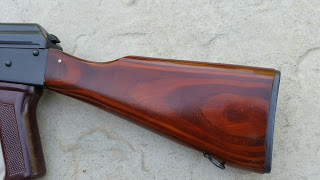 The wood furniture is of the laminated variety and is quite beautiful in appearance, although I would say the finish is not as ‘deep’ as that found on LCT or Real Sword. On the edges where it mates up to the receiver, you can see it’s really kind of a surface application and will chip or scratch off quite easily with your fingernail. I suspect I might refinish the wood on this rifle one day so it’ll hold up better to abuse and wear more naturally.
The wood furniture is of the laminated variety and is quite beautiful in appearance, although I would say the finish is not as ‘deep’ as that found on LCT or Real Sword. On the edges where it mates up to the receiver, you can see it’s really kind of a surface application and will chip or scratch off quite easily with your fingernail. I suspect I might refinish the wood on this rifle one day so it’ll hold up better to abuse and wear more naturally.
The buttstock is a solid piece of wood, with just enough room to hold the cleaning kit inside. One would have to do significant modifications (indeed, to the wiring harness as well) to make this work as a battery storage space. As is, I would recommend end users leave it be as it’s strongest in this configuration.
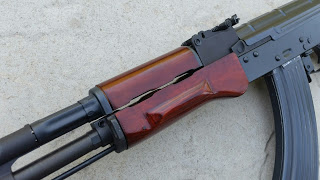 The lone polymer bit on this rifle is the motor grip, which is a plain jane reddish/brown with some rather sharp edges on the checkering. I wound up replacing it right away with one from an LCT that has more of a Bakelite-ish type appearance that was more visually appealing to me.
The lone polymer bit on this rifle is the motor grip, which is a plain jane reddish/brown with some rather sharp edges on the checkering. I wound up replacing it right away with one from an LCT that has more of a Bakelite-ish type appearance that was more visually appealing to me.
The magazine is kind of ‘meh’ in my opinion. It suffers the same flaws as nearly all AK magazines do (except Real Sword mags, which are made from real AK magazines and are durable as hell) in that the front locking lug is held in with a pin. The metal just feels thin and is easy to dent, even with my bare hands. It’s kind of a wobbly affair all-in-all. I ultimately wound up tossing it on the sell pile, and intend to use my Real Sword magazines through this rifle.
Fire it up! Fire it up! …Or not.
Before digging into the guts of the rifle for a further review, I decided to hook up an 11.1v LiPO and give it a test drive to see how it performed straight from the box. I loaded up a magazine with some KSC .20g Perfect’s for an initial chrono-test. The inspection sheet from JAG Precision listed the FPS of this rifle at 375 FPS w/.20g BB’s, which was roughly in line with the sheet issued from E&L (after converting from Joules). This is the point where I ran into several problems simultaneously….
1) Firstly, the rifle would simply not chrono above 320 FPS, even with adjustment of the hop up chamber.
2) I was only able to shoot 6-8 rounds before experiencing a barrel jam.
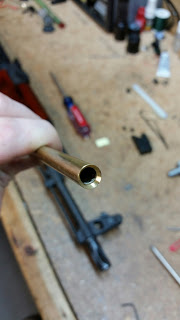
Figuring maybe I had a bad BB mixed in the bag, I attempted to remove it with an unjamming rod. This did not work, however, as the BB was firmly lodged near the crown of the inner barrel. The only way I was able to remove it was by completely disassembling the hop up chamber and barrel – and using a stout nylon rod – tapping it out with a hammer. Upon closer inspection of the area near the crown, I discovered the inner surface of the barrel had an obviously defective and rough internal finish. Attempting to drop a BB through manually resulted in every round catching at the muzzle of the barrel where this defective area was. Ironically, KSC BB’s are a little undersized compared to some brands, with my average measurements being about 5.88mm in diameter. Attempting to use this barrel with any other brand of BB’s resulted in a total failure of any rounds to exit the barrel.
Tearing Her Down….
At this point I decided to do a full teardown of the rifle as well as a replacement of the inner barrel. While I could have sent it back for a warranty claim at this point, I decided to investigate whether there would be further issues – as well morbid curiosity took over. Plus, I’m of the belief that I’d rather prefer to fix something myself than wait on a warranty exchange.
Disassembly of the E&L is nearly identical to that as an LCT or Real Sword, with a few additional steps. The frontset is held in place with two grub screws housed underneath the rear sight assembly. Only one grub is easily accessed via a hole underneath the spring for the leaf sight. On my rifle, I drilled a secondary hole so I could access the 2nd grub screw easier. The hole is concealed by the rear site, so it’s not a noticeable cosmetic issue. It is of note that this was accomplished with just one drill bit, whereas on my Real Sword it took four drill bits to do the same job – a testament to just how tough the RS receivers are in comparison. Incidentally, I have also discovered the rear sight removal tool from Real Sword works perfectly on the E&L and makes removing the leaf sight a breeze.
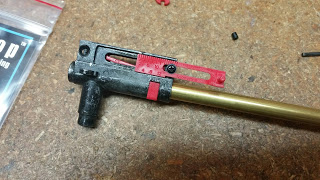
The cast all-metal hop up chamber is attached via two allen screws to either side of the chamber, and a 3rd screw that attaches it to the gearbox. Regarding the hop up chamber – it is in my opinion still as atrocious as ever and a major weak-link of the E&L brand. E&L has updated the plastic bits with slightly better analogues that aren’t as “wet noodle-ish” as that found on the Gen 1’s, but even on the newest generation rifles, this chamber has proven to have terrible air seal, and resulted in a multitude of feeding issues with every magazine brand I tried, including the E&L’s. After some trail and error with various brands of hop up chamber, I found the polymer LCT hop up chamber worked and performed the best in this particular rifle.
The barrel was replaced entirely with an original 455mm 6.01 Dee’s Custom that I’ve had for some years now. While I normally prefer a 6.03 bore, the older Dee’s barrels are still quite excellent in my opinion.
The hop up bucking uses an interesting mound that is slightly reminiscent of that used on the KWA G2X bucking. I honestly never put this bucking to the test adequately, because in my efforts to rectify the massive feeding issues I encountered I wound up installing a Prometheus Purple bucking as a matter of course.
There is also the addition of a over-insertion plate for the magazine which involves unscrewing a pair of slotted nuts from inside the magwell. Speaking of the over-insertion plate, it is made of plastic, and while it does the job, I do not think it will last as long as the one offered from LCT, which is made from steel. I plan to order in the LCT plate to see if it fits.
The gearbox is removed by unthreading the screw that retains the safety selector lever and removing the single screw from the motor grip. At this point you will note that the Gen. 2 gearbox from E&L offers a ball bearing quick-change spring guide, which certainly makes opening up the gearbox easier. I would have preferred the QCS guide to have used an allen key for removal such as Retro Arms uses on their gearboxes rather than a flat blade screwdriver. Due to this, one needs to be careful when installing springs as it’s all too easy for the flat blade to slip off and stab you in the hand (ask me how I know). The spring is a mostly linear pitch type (with tighter coils around the spring guide) that is a bit on the shorter side when compared to the likes of Guarder, Prometheus, Systema and Lonex. The sticker that comes on the gearbox lists it as an “M120” and I would say that is probably accurate.
The gearbox appears decently finished out, with an all-black finish reminiscent of that found on KWA gearboxes. There are some interesting bulges around the cylinder area in what I can only guess pass for radiusing or perhaps reinforcement.
The addition of a new high-torque motor is also a recent addition to the Gen 2 E&L’s. The new motor definitely helps give this rifle that snappy trigger response, especially when paired with an 11.1v LiPo, though I have not gotten around to checking the TPA on it.
Inside the gearbox one is greeted with a brand new set of steel gears that are well lubed. Previously, these were XYT gears in the Gen 1 E&L’s. The new set are laser etched with E&L’s logo and appear to be stronger and overall finished out nicer than the older XYT’s. I do not know who the current manufacturer is of the new gears. The sector gear is assembled from two pieces, similar to SHS sectors. I did not find that they had used thread locker on either of the two allen screws used to keep the halves together. This is something to keep in mind though. There is also a delayer chip installed on the sector gear. It is made of red plastic and in my case kept falling off the sector gear. I replaced this with a metal version from Lonex that fit much tighter.
E&L has also gone with full 9mm bearings all around on the Gen 2’s. The bearings seem to be of decent quality and only time will tell how well they hold up to use. Shimming on this rifle was just “okay, but not great.” There was quite a bit of lateral movement on all three gears and it appears they only use one size of shim at E&L. As such, I wound up reshimming all the gears.
Moving on to the compression parts, we find a one-piece steel air cylinder and cylinder head, which has the E&L logo laser etched into it. I have found that the internal finish of the E&L cylinders is somewhat rough in comparison to other brands. I am not a fan of one piece cylinder setups as they are difficult to AOE correct. I wound up replacing the entire apparatus with a polished brass version, and installed a Lonex aluminum double o-ring cylinder head with a 3/16″ Air-Pad for AOE correction.
Speaking of AOE correction – there is literally none on this rifle. The piston is made from a white polymer material with 3 steel teeth on the release side. The piston head itself is a silent ‘mushroom’ type, which I am not a fan of personally. Despite having only fired a handful of rounds through the rifle before it failed, the pickup tooth of the piston already had a small scallop removed from it due to the poor Angle of Engagement with the sector gear. Compression-wise, this piston assembly also failed the test miserably, likely due to a shrunken o-ring. I replaced the piston with the excellent CYMA full metal rack setup with the 2nd tooth removed for AOE, and installed the also excellent Retro Arms CNC POM piston head to replace the mushroom type. Both of these parts have proven to stand up to lots of abuse and rounds downrange in my experience.
The air-nozzle is indeed an improvement over the earlier Gen 1 nozzles with the addition of an o-ring. While it did seal very well in my testing, I did discover it was incompatible with my LCT hop up chamber. I wound up replacing it with a Real Sword air nozzle with an o-ring that fit better.
The tappet plate is made of the same white polymer as the stock piston. During my quest to achieve a functional rifle, I wound up replacing this with a Lonex tappet plate at some point in the teardown process.
The wiring on the Gen 2’s has also been upgraded to low-resistance silver wiring with a small-Tamiya plug. I left this alone, as well as the trigger switch. I did, however, replace the Tamiya with a Dean’s plug. The trigger switch components seemed decently constructed and suited to the task. All of the soldered joints were well done. Time will tell how well they hold up to continuous LiPo use. I have no intentions of installing a MOSFET on this rifle, as very few of my rifles use a FET, or have even needed one; my Real Swords have been running 11.1v’s since day one and are now over 8+ years old without issue on the stock trigger contacts.
After All That Work….
… I finally had a working rifle! Final FPS was 406 w/.20g BB’s on the stock spring and doing a decent 22 RPS. More importantly, the rifle was also feeding and functioning with all the mags I tested it with – including the stock E&L magazine.
Full list of internal upgrades:
– LCT hop up chamber
– Dee’s Custom (Precision Combat Technologies) 455mm 6.01 TBB
– Prometheus Purple bucking and nub
– CYMA 14 tooth full metal rack piston with 2nd tooth removed for AOE
– Retro Arms CNC POM piston head
– Lonex aluminum double o-ring piston head
– 3/16″ Air-Pad for AOE correction
– Brass air cylinder
– Real Sword Type 56 o-ring air nozzle
– Dean’s plug
– LCT motor grip
Final Notes…
For a brand that relies on so much marketing hype (“Legendary Perfection” comes to mind) I will say that it’s rather disappointing that despite some modicum of improvements to the E&L lineup, quality control issues still very much plague this brand. In fact, this rifle should have never passed through E&L’s quality control, and certainly shouldn’t have passed through JAG Precision’s quality control point as it failed to both properly function and meet “pass” for FPS. The defective barrel alone should have been something that was caught at either inspection. Instead I am left with a couple pieces of uselessly stamped and initialed paper that merely testify it was Friday at the Factory and someone was sleeping on the job. This is not the only E&L I have encountered issues with, however, so I would say they still have quite a bit of catching up to do before they can legitimately dethrone LCT and Real Sword as the top dogs of the Airsoft AK market.
As a tech, I am used to tuning and upgrading rifles to suit my personal needs and the above upgrades I might have done anyway – whether it was a lemon or not. That being said, from the standpoint of a non-tech (your average AEG-purchasing customer) I firmly believe one shouldn’t have to replace well over 3/4’s of the internals to get a properly functioning rifle. It’s simply embarrassing.
All that being said, the externals on the E&L’s are indeed excellent, and I would not hesitate to buy one based on that aspect – with the caveat that some internal work is going to be likely be necessary. To be honest, I’d rather see more of these (and other AEG’s) sold as external build kits, with the internal options left up to the customers choice to outfit.
